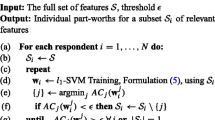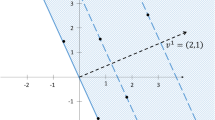Abstract
Support vector machines (SVMs) have been successfully used to identify individuals’ preferences in conjoint analysis. One of the challenges of using SVMs in this context is to properly control for preference heterogeneity among individuals to construct robust partworths. In this work, we present a new technique that obtains all individual utility functions simultaneously in a single optimization problem based on three objectives: complexity reduction, model fit, and heterogeneity control. While complexity reduction and model fit are dealt using SVMs, heterogeneity is controlled by shrinking the individual-level partworths toward a population mean. The proposed approach is further extended to kernel-based machines, conferring flexibility to the model by allowing nonlinear utility functions. Experiments on simulated and real-world datasets show that the proposed approach in its linear form outperforms existing methods for choice-based conjoint analysis.

Similar content being viewed by others
Explore related subjects
Discover the latest articles, news and stories from top researchers in related subjects.References
Abernethy J, Evgeniou T, Toubia O and Vert J (2008). Eliciting consumer preferences using robust adaptive choice questionnaires. IEEE Transactions on Knowledge and Data Engineering 20(2):145–155.
Arora N and Huber J (2001). Improving parameter estimates and model prediction by aggregate customization in choice experiments. Journal of Consumer Research 28(2):273–283.
Atchade YF (2006). An adaptive version for the metropolis adjusted Langevin algorithm with a truncated drift. Methodology and Computing in applied Probability 8(2):235–254.
Bertsekas D (1982). Constrained Optimization and Lagrange Multiplier Methods. Academic Press: New York.
Camm JD, Cochran JJ, Curry DJ and Kannan S (2006). Conjoint optimization: An exact branch-and-bound algorithm for the share-of-choice problem. Management Science 52(3):435–447.
Chapelle O and Harchaoui Z (2005). A machine learning approach to conjoint analysis. In: Osherson DN, Kosslyn SM (eds) Advances in Neural Information Processing Systems, vol 17, pp. 257–264. MIT Press: Cambridge, MA.
Cui D and Curry D (2005). Prediction in marketing using the support vector machine. Marketing Science 24(4):595–615.
Evgeniou T, Boussios C and Zacharia G (2005). Generalized robust conjoint estimation. Marketing Science 24(3):415–429.
Evgeniou T, Pontil M and Toubia O (2007). A convex optimization approach to modeling heterogeneity in conjoint estimation. Marketing Science 26(6):805–818.
Gelman A and Pardoe I (2006). Bayesian measures of explained variance and pooling in multilevel (hierarchical) models. Technometrics 48(2):241–251.
Green PE, Krieger AM and Wind Y (2004). Thirty years of conjoint analysis: Reflections and prospects. In Wind Y, Green PE Marketing Research and Modeling: Progress and Prospects, International Series in Quantitative Marketing, vol 14, pp. 117–139. Springer: Berlin.
Hensher D, Louviere J and Swait J (1998). Combining sources of preference data. Journal of Econometrics 89(1):197–221.
Hsu C.-W., Chang C.-C. and Lin C.-J. (2010). A practical guide to support vector classification. Technical report, Department of Computer Science, National Taiwan University.
Irani S, Dwivedi Y and William M (2014). Analysing factors affecting the choice of emergent human resource capital. Journal of the Operational Research Society 65(6):935–953.
Maldonado S and López J (2014). Alternative second-order cone programming formulations for support vector classification. Information Sciences 268:328–341.
Maldonado S, Montoya R and Weber R (2015). Advanced conjoint analysis using feature selection via support vector machines. European Journal of Operational Research 241(2):564–574.
Maldonado S, Weber R and Basak J (2011). Simultaneous feature selection and classification using kernel-penalized support vector machines. Information Sciences 181(1):115–128.
Mankila M (2004). Retaining students in retail banking through price bundling: Evidence from the swedish market. European Journal of Operational Research 155(2):299–316.
Mercer J (1909). Functions of positive and negative type, and their connection with the theory of integral equations. Philosophical Transactions of the Royal Society of London 209:415–446.
Rosenthal JS et al. (2011). Optimal proposal distributions and adaptive MCMC. In: Brook S, Gelman A, Jones GL, Meng X-L (eds) Handbook of Markov Chain Monte Carlo, pp. 93–112. Chapman and Hall: Boca Raton.
Rossi PE, Allenby GM and McCulloch R (2005). Bayesian statistics and marketing. Wiley: New York.
Schebesch K and Stecking R (2005). Support vector machines for classifying and describing credit applicants: detecting typical and critical regions. Journal of the Operational Research Society 56(9):1082–1088.
Schölkopf B and Smola AJ (2002). Learning with Kernels. MIT Press: Cambridge.
Scholl A, Manthey L, Helm R and Steiner M (2005). Solving multiattribute design problems with analytic hierarchy process and conjoint analysis: An empirical comparison. European Journal of Operational Research 164(1):760–777.
Thyne M, Lawson R and Todd S (2006). The use of conjoint analysis to assess the impact of the cross-cultural exchange between hosts and guests. Tourism Management 27(2):201–213.
Tikhonov AN and Arsenin VY (1977). Solution of Ill-posed Problems. Winston & Sons: Washington.
Toubia O, Evgeniou T and Hauser J (2007a). Optimization-based and machine-learning methods for conjoint analysis: Estimation and question design. In: Gustafsson A, Herrmann A, Huber F (eds) Conjoint Measurement: Methods and Applications, pp. 231–258. Springer: New York.
Toubia O, Hauser J and Garcia R (2007b). Probabilistic polyhedral methods for adaptive choice-based conjoint anaysis. Marketing Science 26(5):596–610.
Tsafarakis S, Grigoroudis E and Matsatsinis N (2011). Consumer choice behaviour and new product development: An integrated market simulation approach. Journal of the Operational Research Society 62(7):1253–1267.
Vapnik V (1998). Statistical Learning Theory. Wiley: New York.
Venkatesh V, Chan FK and Thong JY (2012). Designing e-government services: Key service attributes and citizens’ preference structures. Journal of Operations Management 30(1):116–133.
Verbeke W, Dejaeger K, Martens D, Hur J and Baesens B (2012). New insights into churn prediction in the telecommunication sector: A profit driven data mining approach. European Journal of Operational Research 218(1):211–229.
Yajima Y (2005). Linear programming approaches for multicategory support vector machines. European Journal of Operational Research 162(2):514–531.
Acknowledgments
The authors thank Olivier Toubia and Bryan Orme for providing the data for the two empirical applications. The first author was funded by FONDECYT project 1160894 and by CONICYT Anillo ACT1106. The second author was supported by FONDECYT projects 1140831 and 1160738. The third author was supported by FONDECYT project 1151395 and FONDEF Project IT13I20031. This research was partially funded by the Complex Engineering Systems Institute, ISCI (ICM-FIC: P05-004-F, CONICYT: FB0816).
Author information
Authors and Affiliations
Corresponding author
Appendices
Appendix A
Strictly convexity of problem (6)
In order to prove that our Formulation (6) is strictly convex, we first rewrite it in a compact form. For this, we follow the derivation of Yajima (2005) for multicategory SVM. Let us denote by
and
where \(I_J\) denotes the identity matrix of size J. Then, the quadratic term in (6) can be expressed as
Proposition 1
For any \(\theta >0\), the matrix \({\mathcal{Q}}(\theta )\) is symmetric definite positive. Moreover,
Proof
It is clear that the matrix \({\mathcal{Q}}(\theta )\) is symmetric definite positive (cf. (12)). Now, we denote by \(F_i\in {\mathfrak {R}}^{J\times J(N+1)}\) and \(C_i\in {\mathfrak {R}}^{J(N+1)\times J}\) the i-th block (in row) and the i-th block (in column) of \({\mathcal{Q}}(\theta )\) and \({\mathcal{Q}}(\theta )^{-1}\), respectively. Then,
Thus, the result follows. \(\square\)
Appendix B
Dual formulation of problem (6)
Let us denote by \({\varvec{\xi }}_t^k=(\xi _{1t}^k,\ldots ,\xi _{Nt}^k)\in {\mathfrak {R}}^N\), and by \(\mathbf{X}^k_{t}=\left[ \begin{array}{l} 0\\ X^k_{t} \end{array} \right] \in {\mathfrak {R}}^{(N+1)J\times N}\) with
Then, the constraints of the problem (6) can be expressed as follows
With this notation, the Lagrangian function associated to formulation (6) is given by
Then, Problem (6) can be written equivalently as
Hence, the dual formulation (see eg, Bertsekas, 1982) of (6) is given by
The above expression enables us to compute the dual problem based only on the Lagrange multipliers \(\varvec{\alpha }\). The first-order conditions of the inner minimization problem yields to
Since \(\mathbf{s}_t^k\ge 0\), from (16) it follows that \({\varvec{\alpha }}_t^k\le C\mathbf{e}\) for \(t=1,\ldots ,T\), and \(k=2,\ldots ,K\).
Remark 1
Note that using (1), (15), and the notation of \(\mathbf{X}_t^k\), we have that
On the other hand, by using (15) and (16) in (14), we obtain that
Since \({\mathcal{Q}}(\theta )\) is nonsingular, it follows from (15) that the above expression can be written as
The following result allows us to rewrite the above equality.
Proposition 2
For \(\theta >0\), let \(\widetilde{{\mathcal{Q}}}(\theta )= NI_{JN}+\theta \mathcal{J}\in {\mathfrak {R}}^{JN\times JN}\), where \(I_{JN}\) denotes the identity matrix of size JN and
Then, there exists a symmetric matrix \(\widetilde{{\mathcal{Q}}}(\theta )^{1/2}\) satisfying \((\widetilde{{\mathcal{Q}}}(\theta )^{1/2})^2=\widetilde{{\mathcal{Q}}}(\theta )\).
Proof
Let
Note that \(\mathcal{J}^2=NJ\). Then,
\(\square\)
By using the relation (13), Proposition 2, and the definition of \(\mathbf{X}_t^k\), the expression (17) reduces to
Hence, the dual formulation is given by
Remark 2
From (15) and (13), it follows that
and
for \(i=1,\ldots ,N\).
Rights and permissions
About this article
Cite this article
López, J., Maldonado, S. & Montoya, R. Simultaneous preference estimation and heterogeneity control for choice-based conjoint via support vector machines. J Oper Res Soc 68, 1323–1334 (2017). https://doi.org/10.1057/s41274-016-0013-6
Received:
Accepted:
Published:
Issue Date:
DOI: https://doi.org/10.1057/s41274-016-0013-6




